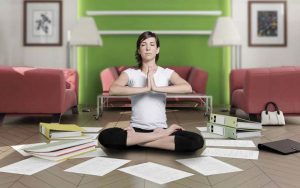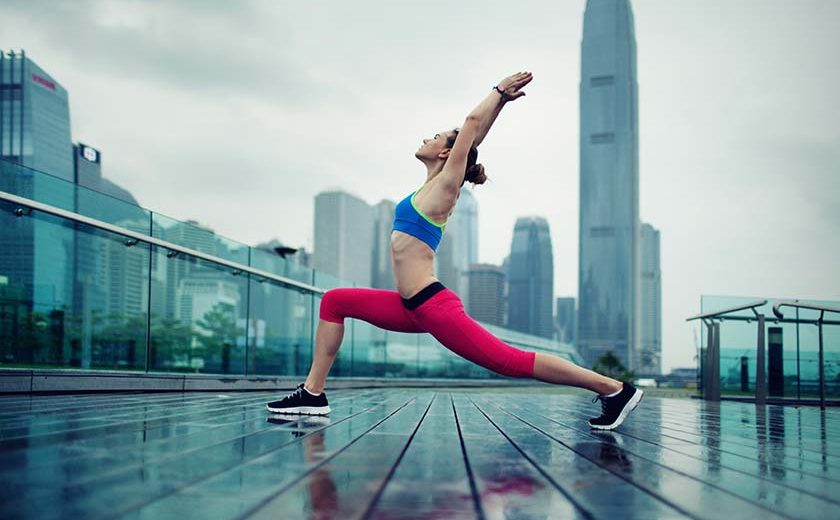Yoga is an ancient, holistic approach to health and wellbeing that promotes harmony between individuals, their community, their natural environment and the wider world. But yoga is not solely about exercise.
What is Yoga?
Yoga is a physical, mental, and spiritual practice which originated in India. The origins of yoga have most likely developed around the sixth and fifth centuries BCE. Yoga gurus from India introduced yoga to the west in the late 19th and early 20th century. In the 1980s, yoga became popular as a system of physical exercise across the Western world. Yoga in Indian traditions, however, is more than physical exercise. It has a meditative and spiritual core.
Yoga is said to be for the purpose of uniting the mind, body, and spirit. Many people think that yoga is just stretching, but while stretching is certainly involved, yoga is really about creating balance in the body through developing both strength and flexibility. This is done through the performance of poses or postures, each of which has specific physical benefits. The poses can be done quickly in succession, creating heat in the body through movement or more slowly to increase stamina and perfect the alignment of the pose. The poses are a constant, but the approach to them varies depending on the yoga tradition in which the teacher has trained.
Research concludes that yoga asana as we know it today came into being in comparatively recent history, through a combination of factors including the international physical culture movement of the 19th century. Evidence indicates that the transformation of yoga asana from a handful of seated poses to the flowing “dance” from posture to posture to which we are accustomed today has largely occurred in the past 200 years, gaining momentum in the past half-century
What are the physical health benefits of Yoga?
A regular practice of Yoga can offer all kinds of physical health benefits. Some, like improved strength and flexibility, are clearly evident. Other may be more subtle and may take longer to develop, but are just as powerful!
Strength: Strength develops as a result of introducing a physical challenge to muscles to the edge of their ability. Many yoga poses do exactly that – they require you to support the weight of your own body in ways that your muscles are not used to, which “forces” your muscles to build strength to support the new task. Holding new poses over the course of several breaths will build up strength; Progressing to more difficult variations of the poses over time will ensure that your strength will keep developing even when you have been practicing for a while.
Flexibility: Modern day living and the natural aging process lead to decreased flexibility, which leads to immobility, tension and often pain. Moving and stretching in Yoga classes will help you become more flexible. Over time, you can expect to gain flexibility in your muscles and improved range of motion in your joints. This will help you move better and with more ease.
Balance: Improved balance is one of the most important benefits of yoga. Poses where you stand on one leg, balance on one hand and one leg or balance on your head and arms are extremely beneficial but must be approach with caution. Always practice at a level appropriate to you and if in doubt make sure you practice in a safe environment and maybe even with someone to support you if necessary.
Joint Health: our joints need to move to their full range and be exposed to appropriate physical demands (compression and de-compression) in order to stay healthy. Yoga poses offer the opportunity to do exactly that in a safe and progressive manner. Of course, you must always make sure you work to your own level and without any joint pain! This way you will see improvement over time.
Injury Prevention: Improved flexibility, strength and balance, improved range of motion in our joints and the ability to move more freely and in a balanced manner can help prevent the causes of many strain related injuries and pain. Tightness, weakness, poor physical control and even spinal compression, can all be addressed with yoga. Yoga also improves your alignment, both in and out of class, which helps prevent many other types of pain.
Better Breathing: Most of us take shallow breaths and don’t give much thought to how we breathe. Yoga breathing exercises, called pranayama, focus the attention on the breath and teach us how to take deeper breaths, which benefits the entire body. Certain types of breath can also help clear the nasal passages (helpful for people with allergies) and even calm the central nervous system, which has both physical and mental benefits.

What are the mental benefits of Yoga?
Yoga’s combined focus on mindfulness, breathing and physical movements brings health benefits with regular practice. The physical health benefits may be easier to observe and measure but the mental ones are just as important.
Mental Calmness: Yoga asana practice is intensely physical. Concentrating so intently on what your body is doing has the effect of bringing calmness to the mind. Yoga also introduces you to meditation techniques, such as watching the breath, learning to observe your “edge” and disengaging from your thoughts. The mental skills acquired in Yoga classes can prove to be very valuable in intense situations of daily life.
Stress Reduction: Physical activity is good for relieving stress, and this is very true of yoga. Because of the concentration required, your daily troubles, both large and small, seem to melt away during the time you are on the mat. This provides a much-needed break from your stressors, as well as helping to put your problems into perspective. The emphasis yoga places on being in the moment can also help relieve stress, as you learn not to dwell on past events or anticipate the future. You will leave a yoga class feeling less stressed than when you started.
Body Awareness: Doing yoga will give you an increased awareness of your own body. You are often encouraged to make small, subtle movements to improve your alignment and you are always encouraged to listen to your body and work to its limits on the day. Becoming stronger, more flexible and more aware of your own body will over time increase your level of comfort in your body, giving you a sense of confidence and achievement.
Can Yoga help my posture?
Yoga is a great way to help improve your posture! Bad posture is a result of not using the body enough and of creating muscular imbalances by using it “incorrectly”. Yoga is designed to bring muscular and postural balance- working all body parts in all directions, stretching tight areas and strengthening weak muscles. The concept of Bandhas or “Yoga Locks” (which may take some time to master) will help you develop a strong sense of “internal lift”, which relates to your core muscles and helps keep you upright. Additionally, the awareness developed in Yoga classes will be carried over to your day-to-day activities, reminding you to carry yourself more upright and with less build-up of tension and bad habits.
Are there any benefits to extra practice at home on top of the classes I take in a studio?
Doing Yoga at home is always a good idea. Apart from the fact that it will help make you stronger and more flexible, it also gives you the opportunity to “own it”- be the one “in charge” of your practice. In the studio one tends to rely on the teacher to check their alignment and the precision of their work. At home you are the one in charge of your own body and this level of awareness and focus will definitely take your practice to new heights! Even 20 minutes of self-practice a couple of times a week will make a big difference and will give you a great sense of satisfaction.
How do I know when I am ready to progress to the next level of classes?
Yoga is a practice that requires the gradual build-up of movement skills (technique), strength, flexibility and awareness. In the process one also develops an understanding of what the objectives of the poses are and how to achieve those objectives. Beyond the pure physical attributes, Yoga creates fine tuning of the body that will manifest itself in the way you carry yourself and the way you move in everyday life and activities. Clearly, this gradual process takes time… sometimes a long time.
There is no need and there is no way really to rush the process… It is a fun process and the real pleasure and satisfaction is in observing the changes that take place in your body with regular, consistent practice as the weeks, months and years go by.
When you feel that you understand the poses, instructions, corrections and cueing really well; and when you feel that you are able to perform the poses really well (maybe even on your own, without a teacher) in a way that does not create stress or strain in your body, then you are probably ready to progress on to the next level!
Am I too old to try Yoga?
At any age and most specifically as we age, it is vital to keep our joints mobile and stable and our posture upright. Yoga does exactly that. Additionally, with awareness of the breath and its focus on continuous and fully expressed breathing; Yoga provides our bodies with much nourishment on a cellular level.
Yoga is so varied; it is good for everyone, no matter the age. Saying that, some of the more physical aspects of the practice would not be appropriate to people with injuries and limitations. If you are fit and well and have been involved in physical practice continuously over the last years and decades then certain physical classes should be appropriate to you. If you have not been physically active and your movement availability is restricted and/or you have considerable limitations, yin and restorative yoga would be good options to try as well as the more meditative Yoga Nidra classes.
As a beginner, how can I benefit the most from Yoga?
The key to your success is being consistent. Make sure to do a number of classes per week and not just the odd class. It is better to practice ‘little but often’ than to take a full hour class once every two weeks. The other very important key to your success is to always be patient and to always be “present” in the class- physically and mentally. Switch off your phone, remove any obstacles and distractions; listen to your body and concentrate on what you are doing; it will make for a much better workout! Motivation wise, think of the class as your reward – your treat at the beginning of the day, a break in the middle of a hectic day or your private-relaxing moment at the end of a long tiring day… Your body and mind will thank you.
Is it okay if my body feels a bit sore after a Yoga class?
Feeling sore is a very individual thing. Some people don’t feel sore at all and some feel quite sore after some classes. It depends on your fitness level, your strength and flexibility and on what you “put into it” during the class. The important thing to remember is that it is fine to feel muscle soreness after physical efforts- the kind of pain that tells you that you have worked hard and your muscles need to recover for a day or two. It is not fine to feel sharp and sudden pains in your joints or pains shooting down your legs or arms. This could mean that you have flared up an underlying problem or an old injury by doing too much too soon. Always remember to do only what is safe and reasonable to you and to progress gradually.


